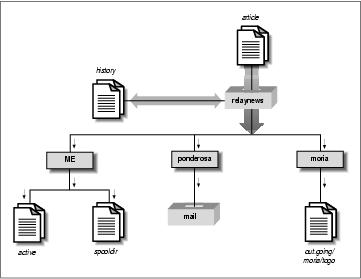21.1. Delivering News
Articles can be fed to C News in several ways. When a local user posts an article, the newsreader usually hands it to the inews command, which completes the header information. News from remote sites, be it a single article or a whole batch, is given to the rnews command, which stores it in the /var/spool/news/in.coming directory, from where it will be picked up at a later time by newsrun. With any of these two techniques, however, the article will eventually be handed to the relaynews command.
For each article, the relaynews command first checks if the article has already been seen at the local site by looking up the message ID in the history file. Duplicate articles are dropped. Then relaynews looks at the Newsgroups: header line to find out if the local site requests articles from any of these groups. If it does, and the newsgroup is listed in the active file, relaynews tries to store the article in the corresponding directory in the news spool area. If this directory does not exist, it is created. The article's message ID is then logged to the history file. Otherwise, relaynews drops the article.
Sometimes relaynews fails to store an incoming article because a group to which it has been posted is not listed in your active file. In this case, the article is moved to the junk group.[1] relaynews also checks for stale or misdated articles and reject them. Incoming batches that fail for any other reason are moved to /var/spool/news/in.coming/bad, and an error message is logged.
After this, the article is relayed to all other sites that request news from these groups, using the transport specified for each particular site. To make sure an article isn't sent to a site that has already seen it, each destination site is checked against the article's Path: header field, which contains the list of sites the article has traversed so far, written in the UUCP-style bang-path source-routing style described in Chapter 17. If the destination site's name does not appear in this list, the article is sent to it.
C News is commonly used to relay news between UUCP sites, although it is also possible to use it in an NNTP environment. To deliver news to a remote UUCP site, either in single articles or whole batches, uux is used to execute the rnews command on the remote site and feed the article or batch to it on standard input. Refer to Chapter 16, for more information on UUCP.
Batching is the term used to describe sending large bundles of individual articles all in one transmission. When batching is enabled for a given site, C News does not send any incoming article immediately; instead, it appends its path name to a file, usually called out.going/site/togo. Periodically, a program is executed from a crontab entry by the cron program, which reads this file and bundles all of the listed articles into one or more file, optionally compressing them and sending them to rnews at the remote site.[2]
Figure 21-1 shows the news flow through relaynews. Articles may be relayed to the local site (denoted by ME), to a site named ponderosa via email, and a site named moria, for which batching is enabled.
